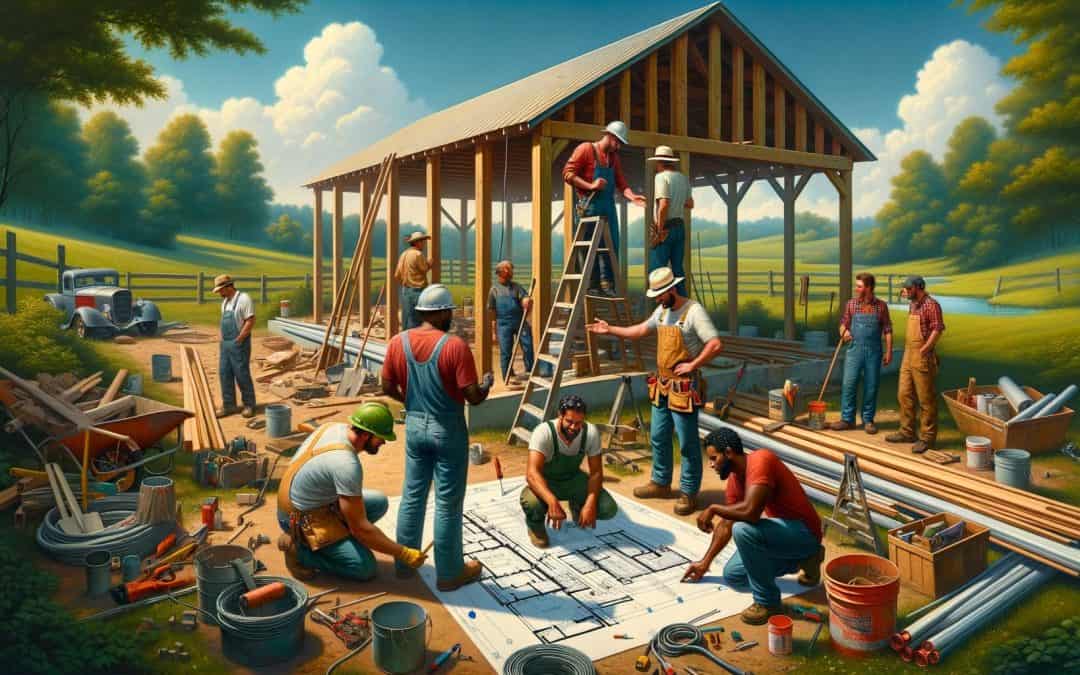At Outbuilders, we often get asked: “Do pole barns need footings?” It’s a crucial question for anyone considering this type of structure.
Pole barns are known for their simplicity and cost-effectiveness, but their foundation requirements can vary. In this post, we’ll explore the different footing options for pole barns and help you understand what’s best for your project.
What Is a Pole Barn?
The Basics of Pole Barn Construction
Pole barns are versatile, cost-effective structures that have gained popularity for various uses, from agricultural storage to residential living spaces. At their core, pole barns are post-frame buildings that use large poles or posts buried in the ground to support the roof and walls.
Key Components
The main elements of a pole barn include:
-
Trusses
-
Purlins
-
Metal sheeting for the roof and walls

Unlike traditional buildings, pole barns don’t require a continuous foundation. The poles are set directly into the ground or on concrete piers, which significantly reduces construction time and costs.
The Role of Foundation
The foundation plays a critical role in the stability and longevity of a pole barn. The depth and method of setting the poles greatly impact the building’s ability to withstand wind loads and prevent settling over time.
Soil Types and Their Impact
The type of soil on your property is a key factor in determining the best foundation approach for your pole barn. For instance, in Central Oregon (where volcanic soil is common), specific considerations must be made. Clay-heavy soils may require deeper footings to prevent frost heave, while sandy soils might benefit from wider footings to distribute the load more effectively.
Climate Considerations
Climate also influences foundation decisions. In areas with deep frost lines, poles may need deeper burial to prevent frost heave. For example, in some parts of Minnesota, poles might need a 5-foot depth, while in warmer climates, 3 feet might suffice.
Properly constructed pole barns can last 40-60 years with regular maintenance. This longevity largely depends on the initial foundation work, highlighting the importance of getting it right from the start.
As we move forward, it’s important to understand the specific footing options available for pole barns. Let’s explore these options in detail to help you make the best choice for your project.
Why Footings Matter in Pole Barns
The Purpose of Footings
Footings serve as the foundation for pole barns, distributing the structure’s weight evenly across the soil. They prevent settling and structural issues while anchoring the poles to resist uplift forces from wind and provide lateral stability. In areas with expansive soils or freeze-thaw cycles, footings help reduce the risk of frost heave and soil movement.
Common Footing Types for Pole Barns
Several footing options exist for pole barns, each with its own advantages:
-
Concrete Piers: These cylindrical concrete footings are poured into holes where the poles will be placed. They work well in most soil types and provide excellent stability.
-
Precast Concrete Pads: These ready-made concrete blocks are placed at the bottom of each pole hole. They allow for quick installation but may not suit all soil conditions.
-
Monolithic Slab: This option involves pouring a concrete slab that functions as both the foundation and the floor. It suits pole barns used as workshops or living spaces.
-
Continuous Concrete Footings: Similar to traditional house foundations, these provide maximum stability but cost more and take longer to install.
Factors Influencing Footing Requirements
Several factors determine the type and size of footings needed for a pole barn:
-
Soil Type: Sandy soils often require wider footings, while clay soils might need deeper ones to prevent heaving.
-
Climate: In areas with deep frost lines, footings must extend below the frost depth to prevent frost heave. (The minimum required foundation depth is 12″ according to the 2018 IRC with Georgia Amendments, Section R403.1.4, though some jurisdictions may require deeper foundations.)
-
Building Size and Load: Larger buildings or those designed to carry heavy loads (like equipment storage) require more substantial footings.
-
Local Building Codes: Always check local regulations, as they often dictate minimum footing requirements based on regional conditions.
-
Intended Use: A pole barn used for livestock will have different footing needs than one used as a residential space.
The Importance of Professional Assessment
When designing pole barn footings, consider these factors holistically. Each project requires individual assessment, taking into account specific site conditions and client needs to determine the most appropriate footing solution. This approach ensures the longevity and stability of the structure. Proper maintenance helps prevent erosion, shifting, and settling of the foundation, which can lead to structural issues over time.
Investing in Quality Foundations
While pole barns are known for their simplicity, skimping on the foundation can lead to costly problems in the future. Proper footings are key to ensuring your pole barn stands strong for decades. The next section will explore alternative foundation options that can provide additional benefits for specific pole barn projects.

Alternative Foundation Options for Pole Barns
Concrete Piers: A Solid Choice
Concrete piers have become a popular option for pole barn construction. These cylindrical concrete footings are poured into pre-dug holes where the poles will be placed. They offer excellent stability and work well in most soil types.

Concrete piers distribute the building’s weight more evenly than traditional buried posts. This proves particularly beneficial in areas with poor soil conditions. In parts of Central Oregon (where volcanic soil is common), concrete piers provide a more stable foundation than direct-buried posts.
The size of concrete footings for pole barns can vary depending on factors such as soil conditions, building size, and local building codes. It’s important to consult with a professional or refer to local regulations to determine the appropriate dimensions for your specific project.
Helical Piers: The High-Tech Option
Helical piers, also known as screw piles, offer a modern alternative in pole barn construction. These steel shafts with helical plates are screwed into the ground using specialized equipment.
Helical piers can be installed in various weather conditions and soil types. They prove particularly useful in areas with high water tables or expansive soils where traditional footings might cause problems.
Another advantage of helical piers is their immediate load-bearing capacity. Unlike concrete, which needs time to cure, helical piers can support weight as soon as they’re installed. This speeds up the construction process significantly.
However, helical piers typically come with a higher upfront cost compared to traditional footings or concrete piers. The specialized equipment and expertise required for installation contribute to this increased cost.
Gravel Foundations: A Simple Solution
For smaller or temporary pole barn structures, a gravel foundation can be a cost-effective option. This method involves excavating the site, laying a geotextile fabric, and then filling the area with compacted gravel.
Gravel foundations offer excellent drainage, which proves essential in areas prone to water accumulation. They’re also relatively easy to install and can be a good DIY option for those with the right equipment.
It’s important to note that gravel foundations may not suit larger structures or areas with strict building codes. They also don’t provide the same level of stability as concrete piers or helical piers, especially in regions with freeze-thaw cycles.
In Central Oregon, gravel foundations work well for smaller storage sheds and temporary structures. However, for larger pole barns or those intended for long-term use, more robust foundation options are recommended.
When considering alternative foundation options for your pole barn, consult with local building authorities and experienced contractors. The right choice will depend on your specific site conditions, local regulations, and the intended use of your pole barn (e.g., storage, livestock housing, or workshop).
Final Thoughts
The question “Do pole barns need footings?” has no universal answer. Foundation requirements depend on soil conditions, climate, building size, and intended use. Local building codes specify minimum requirements based on regional conditions to ensure safety and longevity of structures.

Soil conditions play a critical role in choosing the right foundation. Different soil types require different approaches to prevent issues like settling or frost heave. The structure’s intended use, budget, and long-term plans also influence the decision on the best foundation for a pole barn.
At Outbuilders, we understand the importance of a solid foundation for any structure. Our team can guide you through the process of choosing the right foundation for your pole barn. We specialize in customized storage solutions, including pole barns (our on-site construction allows us to adapt to various site requirements).







Trackbacks/Pingbacks